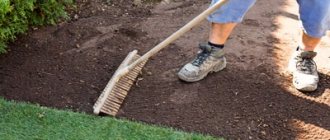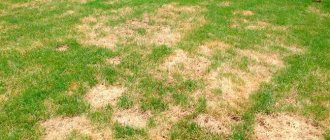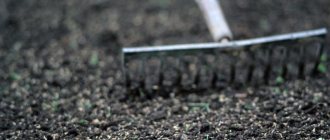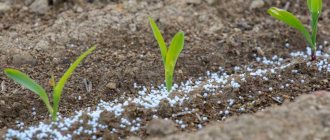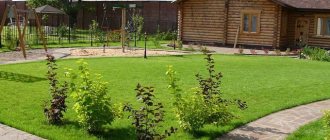The popularity of lawns is constantly growing. Increasingly, you can see in the courtyards of private property not vegetable gardens planted with vegetable crops, but lawns of green grass. Often, home owners plant a lawn on their own, so it is important to know how and when it is best to do this. There are two main times for sowing grass - spring and autumn, and each season has its own characteristics that must be taken into account so that the work is not in vain.
In which regions?
The timing of spring lawn planting depends on the climate of a particular region. In the southern regions of Russia, the optimal time for sowing a lawn is considered to be the beginning of March .
In regions located in the middle zone, the time for completing such work is pushed back to mid-April - early May.
In any case, you can sow grass in the spring only when the soil is still moist and has already been warmed by the sun.
The advantage of spring sowing of grass is that by the autumn cold, the grass cover becomes fully formed and gains strength; it is no longer afraid of winter frosts.
What types and varieties are best to sow?
If for sowing a lawn in the fall it is better to use grasses that grow quickly, then for spring planting any varieties of grass are suitable, including slow-growing ones, including bluegrass and various types of fescue. They manage to go through the entire growing season and finally form before the onset of winter cold.
- Oak grove bluegrass . Low grass, grows well in the shade, but does not tolerate mechanical damage and trampling. Does not like frequent mowing; can be sown under fruit trees.
- Meadow bluegrass . Perennial grass, unlike oak bluegrass, forms a dense turf that is resistant to mechanical stress and quickly restores the grass cover. Due to the fact that it takes a long time to germinate, it is suitable for spring sowing.
- Red fescue . Tolerates frost and weather changes. It does not require care, is resistant to drought and lack of sunlight. It practically does not get sick and does not allow weeds to grow.
- Hedgehog team . Unpretentious grass, tolerates any weather conditions, does not require sun. Thanks to its developed root system, it is suitable for landscaping slopes and slopes. It is resistant to trampling, but can form bald spots, so it is more often used in grass mixtures.
Seed selection
When choosing seed, it is important not to make a mistake. Poor seed germination will cause a lot of trouble in the future. Removing an old lawn in order to plant a new one is a labor-intensive and quite expensive process. Good seeds are expensive, but after germination the lawn looks presentable.
When choosing seed mixtures for sowing a lawn, it is better to give preference to those varieties that are more suitable for the local climate and soil. The most popular herbs included in the mixture are:
- timothy grass;
- red fescue, meadow fescue, sheep fescue;
- rump is soft, awnless;
- thin, dog-like, white bentgrass;
- bluegrass, meadow, forest, annual.
Experts select the composition of the mixture so that the herbs combine harmoniously with each other and sprout together.
Rules and requirements for the sowing process
Lawn grass should be sown in spring only when the air warms up to +15°C and the soil temperature is at least +10°C. This way, seedlings will appear faster, thanks to moist and warm soil.- If possible, it is better to prepare the area for spring sowing in the fall: clean, level, dig, feed with fertilizers.
- It is advisable to fertilize the soil during spring sowing with nitrogen-containing fertilizers.
- Before sowing, divide the plot into squares, sowing them one at a time so that the planting material can be evenly distributed over the lawn.
- It is better to sow in sunny, windless weather.
- If spring is hot, then water the crops every day with a spray bottle.
Time to board
The most important question is when to plant seed? Of course, there is no strict date: the seeds sprout throughout the warm season. It is worth considering all periods of the year and assessing how suitable each of them is for sowing.
Winter
The cold period is difficult for plants: they reduce vital activity to the minimum necessary for survival. Therefore, planting seeds before winter is a risky undertaking. These days, the matter is aggravated by the instability of weather conditions: sudden warming in December will force the seeds to hatch and enter the growing season, and in this form the grass will not withstand subsequent frosts 100%.
However, some gardeners decide to plant lawn grass before winter, for the following reasons:
- seeds undergo natural stratification (exposure to certain temperature conditions). This hardening gives them endurance and vitality;
- early shoots will take advantage of the abundance of moisture in the soil caused by melting snow and spring rains. This is especially true for regions where there are problems with irrigation;
- It happens that there is a need to have a ready-made lawn in the spring, but it was not possible to plant grass in the fall. When planting before winter, the grass will appear 1.5 months earlier than this could be achieved during spring planting (thaw prevents sowing early in the spring).
When planting before winter, some of the seeds will inevitably die. Taking this into account, the seeding rate is increased by 1.5-2 times. You need to sow at a temperature no higher than +30C, otherwise there is a risk of seed germination.
Spring
The most favorable period.
The weather is already warm, and the plants are developing quickly, but there is still no heat, which they, like cold, can hardly tolerate. The whole warm season is ahead and the shoots will have time to develop and get stronger in order to survive the winter well. Sowing work in the spring begins when the temperature in the soil reaches +80C - +100C and it dries out, when you can walk on it without leaving disfiguring marks.
If a snowdrift lingers on the future lawn, it is scattered with a shovel to speed up the melting. At the same time, it is again important to avoid damage to the soil foundation by deep tracks or ruts: wooden panels are laid on the soggy ground and moved along them.
Summer
Summer is not very suitable for sowing for the following reasons:
- heat, although to a lesser extent than cold, also makes life difficult for plants, especially young and fragile ones;
- Newly sprouted grass desperately needs a lot of moisture, so in hot conditions it will have to be watered very often.
If it still didn’t work out to plant a lawn in the spring and you have to do it in the summer, choose the most gentle periods - June and the end of August.
At this time, negative summer factors - heat and lack of natural moisture - manifest themselves to the least extent.
Autumn
In autumn, sowing work begins earlier - in September. If you delay, the grass will not have time to gain strength before winter and, for the most part, will die from frost. When sowing in September, the plants will have enough time, and the weather is still warm, which is necessary for their rapid development.
An important advantage of autumn sowing is the rains characteristic of this time of year. As already mentioned, young shoots that have not had time to take root need moisture extremely.
How to plant with your own hands?
The lawn sowing procedure consists of several stages, including preparatory work.
- The area for the lawn is cleared of debris, stones, and weeds. If there are stumps, they are uprooted, removing all elements that may interfere with the creation of a flat surface for the lawn area.
- The soil is plowed or dug up, and its composition is adjusted. If necessary, depending on the composition, peat, sand, and black soil are added.
- Simultaneously with digging, mineral and organic fertilizers are applied.
- They pass over the area with a garden roller, compacting the surface and at the same time breaking up large clods of earth.
- The area is left fallow for a period of 2-3 weeks.
- Before sowing grass, they pass through the area with a fan rake to fluff up the soil.
- The soil should be spilled with water in advance so that it is saturated 2-5 cm deep.
Next comes the main point - sowing grass. This should be done on a windless day so that the seeds do not scatter throughout the area .
You can sow either manually or using a seeder. Seed consumption is on average 40 g per 1 sq. m. If you have to sow without the use of technology, then the seeds of one grass or a mixture of herbs are mixed with sand. The seed material is scattered manually in a fan across the site, passing it in two directions - along and across, so that there are no missed spots.
When using a seeder, seed material is poured into the device container . The seeder ensures uniform scattering of seeds over the soil surface.
After the lawn is sown, you should go over it again with a fan rake, lightly sprinkling the seeds with soil. After this, press down the sown area with a garden roller.
Rolled or seeded lawn?
Impatient people who don't have time to maintain a garden and want a thick green carpet in front of their house resort to the simple method of laying grass in rolls. But is this really a faster, more convenient and more effective option for getting a beautiful lawn? A short comparison of rolled and seeded grass dispels these doubts.
Disadvantages and advantages of seeded lawn
| Advantages | Flaws |
| Cheaper option | Difficulty choosing the exact date for sowing grass |
| Works well over large areas | Seeds require special sowing conditions |
| Develops a more extensive root system, resulting in stronger, more resilient grass | Labor-intensive site preparation |
| It is forbidden to walk on the grass until it gets stronger |
Disadvantages and advantages of rolled lawn
| Advantages | Flaws |
| Works well in small areas | Higher cost |
| Speed | Labor-intensive site preparation |
| It has no special care requirements, is versatile and can be planted in many places, even on sloping surfaces | High requirements for soil composition |
| No weeds | The need for quick installation |
Possible difficulties and errors
In order for the spring sowing of the lawn to be successful and a beautiful dense green carpet to be formed, you should try to avoid some mistakes when performing this work , and become familiar with them before deciding to sow.
- Choosing the wrong type of grass. For brightly sunny and shady areas, you should select the appropriate variety of herbal mixture. To correct this situation, next season you should sow the grass of the desired variety, choosing not herbal mixtures, but mono-herbs.
- Poor cleaning of the lawn area can cause yellow spots to appear on the grass.
- Watering too much immediately after sowing can cause the seeds to float and the soil cover to be washed away. That is why spring sowing is good because the seeds are immersed in still moist soil.
- Sometimes plywood sheets are used to compact the earth - their weight is not enough to perform this operation efficiently. If there is no garden roller, then it is better to prepare an iron barrel filled with water or sand.
- In the first year after sowing, there is no need to fertilize the lawn; the fertilizers that were applied when preparing the site are sufficient for the development and growth of young grass. Otherwise, you can burn the roots of young plants.
- To prevent lawn grass from “spreading” over an area where other plants are already growing, before sowing, you can install border fences made of plastic or galvanized iron - they will not allow the seeds to spread beyond the boundaries of the area. After the lawn grass has grown, the fences are removed.
Site preparation
The first and most important stage is when the future lawn is marked, cleared of weeds and leveled. Careful preparation will save you from weeding and make mowing an already grown lawn easier. The time required to prepare the site is from 1 to 4 weeks.
- The lawn is marked in accordance with the site plan, and flower beds, edges, paths and paths are immediately laid. It is convenient to mark using pegs and twine. Strict geometric lines are not suitable for all types of lawns; flowering meadows and lawns look more harmonious if they do not have clearly defined boundaries with right angles.
- The area is treated with a general herbicide. Areas overgrown with particularly stubborn weeds with increased seed germination must be treated in several stages with an interval of two weeks. Young May vegetation is more susceptible to the action of herbicides. When treated in autumn, some of the seeds may go away during the winter and germinate in the spring. The herbicide consumption depends on the weed infestation of the area and the type of chemical.
Treating the area with herbicide - After the grass withers and dries, the area is cleared of bush roots, debris, dried grass and leveled. If the soil on the site is poor and requires the addition of a large amount of fertile soil, you can finally get rid of the weeds by covering the entire area of the lawn with geotextiles. This non-woven fabric will not allow weed seeds to germinate, and nothing will disturb the lawn grass.
Advantages and disadvantages
Advantages:
- The most active time for the development of any plants is spring. Therefore, if you want to quickly grow lawn grass, then this time of year is the most suitable for this purpose.
By sowing grass in damp soil in the spring, you can get a green lawn already in the same year.
- Spring sowing allows you to timely notice and eliminate mistakes made when arranging your lawn. In a month, all the shortcomings in the work will be visible: missed areas and uneven sowing.
But spring sowing of lawn grass also has its disadvantages :
- the area for spring sowing will need to be prepared in the fall: cleared of debris, dug up, fed with fertilizers;
- In the spring, not only cultivated plants grow actively, but also various weeds, which will have to be fought very actively.
What you need for work
To plant grass on your lawn with your own hands, you do not need any specific technical means or special tools. To do this, use ordinary gardening tools:
- garden shovel;
- fan rakes;
- wheelbarrow;
- heavy pipe for rolling and leveling the soil;
- roulette;
- twine;
- pegs.
Important! When the soil composition does not meet the recommended standards, the top layer of soil is removed (20-30 cm), then sand and crushed stone are poured, and fertile soil is added on top. Sometimes it’s enough just to get by with special weed killers or fertilize the soil.
How many sprout?
The germination time of lawn grass depends on several factors:
- climatic and weather conditions;
- composition and type of soil (sandy, loamy, etc.);
- the site is located in the sun or in the shade;
- expiration date of the herbal mixture purchased in the store;
- the presence or absence of a drainage system;
- proper care of crops.
The most popular varieties for sowing lawns are cereal crops . Their germination period ranges from 8 to 16 days, depending on the type of lawn grass. For example, bluegrass has many varieties. Germination of this species in spring ranges from 10 to 14 days. A dense grass mat will appear within about a month after the shoots appear.
Ryegrass sprouts appear after 7-12 days and after three weeks the grass begins to bush. Fescue sown in spring emerges in 10 days, and after 4-6 weeks it can already produce color if it is not trimmed in time.
Aftercare
In lawn care, special attention should be paid to regular watering during the first 2 weeks after planting, 2-3 weeks after germination, when leaf formation and root system development are active, as well as in hot, dry weather, so that the greens do not become coarse and take on a fading appearance. .
Among the specific agricultural techniques for cultivating lawn cereal crops at the initial stage of growth, when the grass reaches a height of about 5 cm, rolling is carried out using the lightest roller. This is done in order to compact the soil raised by densely growing seedlings. After a few days, the young plants will recover and again create an impenetrable cover. It is recommended to start mowing after the grass has grown to 9-10 cm. In the future, the green “carpet” requires regular mowing (about once a week), in which the height of the grass stand is maintained at 5-6 cm.
Special equipment - lawn mowers, verticutters, scarifiers and trimmers - helps to give the lawn an impeccable, well-groomed appearance.
For full development, plants need fertilizing, aeration, as well as preventive treatments against diseases and pests.
Aeration is necessary to maintain the vital activity of soil microorganisms and the development of the root system. To allow air to penetrate into the deeper layers of the soil, the lawn is pierced in different places with a garden fork.
